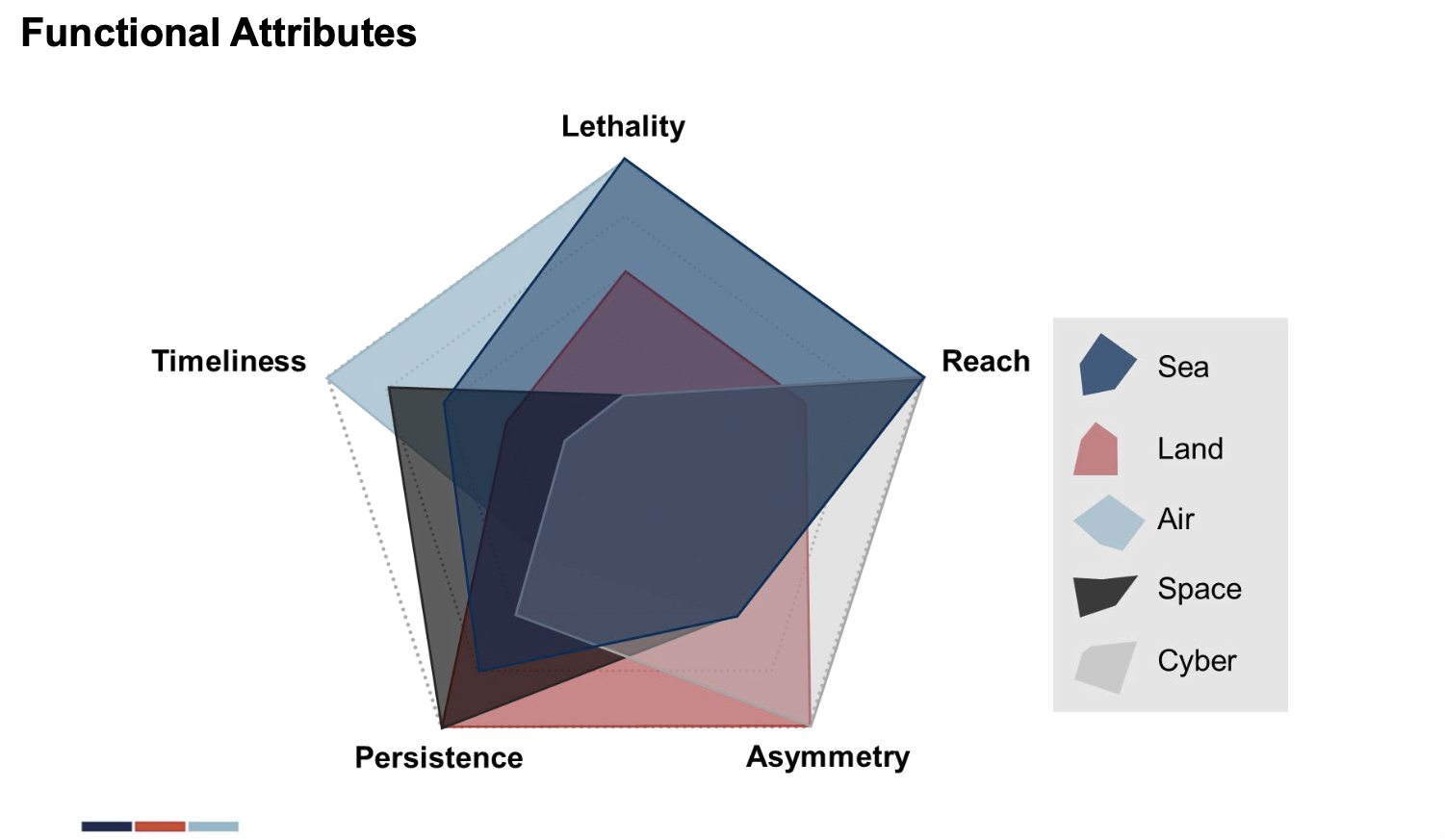Deterrence by Denial, Impactful Projection, Proportionate Response and Multi-Domain Strike
When reading through the Australian Government’s 2023 Defence Strategic Review (DSR), three core concepts stand out: deterrence by denial, the need to craft more impactful projection and, thirdly, to do so in order to have the capability for proportionate response.
Let me review what the DSR said about these objectives and their relationship with one another.
The DSR on page 37 provides a broad perspective on the purposes of the force structure redesign:
“Current Australian defence policy is based on deterrence through denial. This military application of deterrence theory is based on the concept of establishing effective defence capabilities relative to the threat.
“Current defence deterrence policy is based on demonstrating an ability to independently defeat threats within our immediate region. This was credible with a force structure postured for low-level and enhanced low-level regional threats.
“Australia does not have effective defence capabilities relative to higher threat levels. In the present strategic circumstances, this can only be achieved by Australia working with the United States and other key partners in the maintenance of a favourable regional environment. Australia also needs to develop the capability to unilaterally deter any state from offensive military action against Australian forces or territory.
“Although invasion of the Australian continent is a remote possibility, any adversary could seek to coerce Australia through cyber attacks, incursions in our north west shelf or parts of our exclusive economic zone, or disruptions to our sea lines of communication. By developing a resilient and capable ADF that can hold forces at risk in our northern maritime approaches, Australia could deter attacks on Australian forces or territory.”
The DSR on page 19 identifies the capabilities which are prioritized by the review: “The ADF’s operational success will depend on the ability of the Integrated Force to apply the following critical capabilities:
- undersea warfare capabilities (crewed and uncrewed) optimised for persistent, long-range sub-surface intelligence, surveillance and reconnaissance (ISR)
and strike; - an enhanced integrated targeting capability;
- an enhanced long-range strike capability in all domains;
- a fully enabled, integrated amphibious-capable combined-arms land system;
- enhanced, all-domain, maritime capabilities for sea denial operations and localised sea control;
- a networked expeditionary air operations capability;
- an enhanced, all-domain, integrated air and missile defence capability;
- a joint, expeditionary theatre logistics system with strategic depth and mobility;
- a theatre command and control framework that enables an enhanced Integrated Force; and
- a developed network of northern bases to provide a platform for logistics support, denial and deterrence.”
Impactful projection is discussed notably on pages 6 and 106 of the review. “As most of these objectives lie well beyond our borders, the ADF must have the capacity to engage in impactful projection across the full spectrum of proportionate response. The ADF must be able to hold an adversary at risk further from our shores.” (Page 6)
Then on page six: “Accordingly, the Australian Defence Force (ADF) must have the capacity to:
- defend Australia and our immediate region;
- deter through denial any adversary’s attempt to project power against Australia through our northern approaches;
- protect Australia’s economic connection to our region and the world;
- contribute with our partners to the collective security of the Indo-Pacific; and
- contribute with our partners to the maintenance of the global rules-based order.
“The Government agrees that new technology and asymmetric advantage is a priority, and will ensure the ADF has the capacity to engage in impactful projection across the full spectrum of proportionate response.” (Page 106).
In the Williams Foundation seminar on multi-domain strike held on 27 September 2023, several ADF speakers provided insight with regard to ADF thinking about the way ahead to achieve these inter-related objectives.
LTGEN Frewan, Chief of Joint Capabilities, argued that “the DSR is calling for the Australian Defence Force to become a fully integrated force. And this infers something beyond joint. It requires an ADF integrated by design, rather than the three services being required to operate together in often ad hoc and imperfect ways.
“And integration also applies to our command-and-control systems, our targeting systems and our enabling and sustainment capabilities.
“The DSR shifts the priority for the ADF from a balanced force to a threat focused force utilizing a net assessment of our strategic and tactical challenges, and we must build an ADF that can deter or succeed against our immediate potential adversaries.”

A key aspect of the multi-domain strike enterprise which Frewan discussed was the sustainment and logistics part of the enterprise. “Targeting, even in its most kinetic sense, will require a resilient logistics network to deliver munitions, maintenance and sustainment. It will be folly to develop a sophisticated targeting enterprise that does not have comparable investment in a logistics enterprise which has in recent decades been designed for efficiency rather than resilience.”
MAJGEN Brett Mousley, Head of Intelligence Capability, Defence Intelligence Group, emphasized the significant change in targeting capabilities required for the kind of strategic impactful projection which the DSR calls for.
“We are now required to support our own sovereign plans and be ready to execute them at pace and scale… Our strategic settings also demands that the joint targeting cycle is always on, and therefore active in competition as well as in conflict. Early identification of the potential threats to the status quo, or actions that could lead to a deterioration in the security environment must be acted upon quickly with appropriate and non-escalatory effects to prevent or dissipate any potential crisis.
“And as you also know, the ADF is acquiring advanced systems including Long Range Strike weapons, expanding its suite of non-kinetic effects, and increasingly operating in and through the contested cyber and space domains.
“Importantly, from a Defense Intelligence Group perspective, the DSR has now given us the clear direction to accelerate the development and delivery of the key underpinning systems that support the processing, exploitation and dissemination of collected intelligence, including the ability to produce intelligence mission data, at greater volumes and velocity to support all aspects of targeting, from identification, to engagement and to assessment for all our key platforms, and weapon systems.”

Mousley then discussed what he saw as the three key challenges which needed to be met to make progress along these lines.
“Firstly, scaling the enterprise, we must be able to move from a workforce supporting a niche element in a single service against a small number of targets to supporting a much broader range of targets simultaneously across all domains….”
He then discussed the need to “modernize our targeting databases and tools, ensuring they can process the significant volume of targeting information across all domains. We need to make a foundational military intelligence capability accessible across the entire enterprise whilst maintaining strong interoperability with our key allies.”
And the third aspect was “the speed of decision making.
“The tempo of modern warfare will be high and opportunities to apply multi-domain effects will be fleeting, and will rely on well trained well-rehearsed forces and leaders who are informed to make timely decisions in a chaotic environment.
“Intelligence for targeting indeed for all areas of intelligence support to operations will need to sift through and analyze the afore mentioned data to rapidly generate intelligence making it accessible to plans, operations and logistics staff. Only then will we be able to support leaders with timely and accurate advice and recommendations in order to execute the right effects at the right time and place.”
RADM Stephen Hughes, Head Navy Capability, underscored that when focusing on the maritime domain, one is inherently focused on multi-domain strike. The maritime warfighting domain is shaped by strike whether coming from land, surface, subsurface or air domains, as well the cyber and space domains.
“To attain long range strike capabilities allows us to move from a strategy of defense to a strategy of deterrence through denial which signifies a national shift that aims to hold an adversary at risk a greater range raising a question in the adversaries mind about whether they want to attempt to act against us.
“So what does the maritime force bring to the fight?
“A maritime force is able to be agile, mobile expeditionary scalable, sustainable, versatile, networked and lethal. Maritime force provides critical advantages through their ability to use the oceans to maneuver and hide in the case of submarines, and the airspace and the space above that domain. Maritime force combines distributed fleet operations, and mobile expeditionary forces with sea control and sea denial capabilities.

“However, a maritime force does not compete, deter or fight alone. The maritime force is an integral part of the joint force and works closely with allies and partners to bring to bear maritime effects. Controlling the seas enables the maritime force to project power in support of Joint Force efforts. surging into the theater of operations, where adversaries must cross open water. Sea denial deprives them the initiative prevents them from achieving their objectives.
“Maritime force controls or denies the seas by destroying an adversary’s fleet or their associated air support. And in in the modern battle space even extends into space. It can contain it in areas that prevents meaningful operations prohibited from leaving port by controlling sea lines of communication. Maritime forces capable of controlling critical choke points enable joint forces to impose military and economic costs on the adversary.”
He also added comments with regard to the innovation which Navy is working to enhance multi-domain strike. “The future of our strike capability needs to include the use of uncrewed systems. Navy is working with industry in exploring solutions through the autonomous warrior series of experimental exercises. And such systems will have the ability to strike deep against an adversary by deploying mines and other guided weapons by using sovereign Australian capabilities.”
As he underscored: “The defense strategic review has placed a premium on accelerating lethality for deterrence and impactful projection,”
He cited the examples not only of acquiring TLAMS but the development of greater maritime strike capabilities. against maritime forces, whether from an F-35 or from anti-ship missile capabilities.
AVM Stephen Chappell, Head of Military Strategic Commitments, focused on the symbiotic relationship between offense and defense with regard to multi-domain strike.
“Integrated air and missile defense and multi-domain strike are two sides of the same coin. By having an ability to protect our strike enterprises we enhance their credibility to strike back which ensures as well our enhanced deterrent capability.”

He underscored: “Passive defense is just as important not only for defending critical assets, but preserving our multi-domain strike capabilities in order to execute those left jabs and those right hooks necessary. The next layer of defense we’re thinking about is counter force. This in effect is multi-domain strike, the ability to reach out and defeat a threat to our homeland or to our forces. Deterrence by denial includes that defensive protection of the chin as we deliver effective left jabs and right hooks.”
And finally, COL Casey Guidolin, Director ADF Multi-Domain Strike, provided a very clear analysis of multi-domain strike and its role in deterrent capabilities.
“When considering multi domain strike, we must consider what each domain intrinsically brings and how they can be applied within our strategic geography to best effect.
“Firstly, maritime forces provide lethality reach and persistence from on, above, or under the ocean surface. However, maritime strike weapons are often unique and expensive. And consideration must be given to the speed of maritime forces and distances required to travel to launch a strike as part of an orchestrated action and the subsequent time to return to port for reloading. Submarines have an inherent attribute of stealth range and significant strike power, as well as being able to conduct ISR covertly.
“Land Forces possess unique attributes that contribute to joint forces in that they can disperse far more than air or naval forces. Land Forces are persistent in posture and presence for extended periods and can have utility in applying asymmetric responses with greater depth and capacity for strike capabilities.
“Land Forces currently lack the reach required to match or overmatch adversary strike weapons. And the need to maneuver within striking distance of an adversary means that like maritime forces, the time required to travel to launch a strike as part of an orchestrated action must be considered. Persistent forward basing will improve reaction and response times.
“Special Operations Forces offer a unique contribution to multi-domain strike through their inherent agility and stealth and ability to operate in and across all domains.
“Air domain capabilities and operations are optimized to be relatively light and fast to magnify air powers utility as a first response option that enables access for heavier and more enduring elements of national power. Air Force can contribute to or enable an immediate or short-term response.

“Air Force capabilities can be equipped and postured to provide immediate, impactful options with light footprints as the timeliness and impact can have significant bearing on the outcome to support a multi-domain strike.
“Space capabilities provide the ADF with diversity and resilience of communications through defense satellite communications. Space assets also provide the ADF with vital intelligence, surveillance and reconnaissance capabilities. Importantly, all three are different capabilities. It’s not just ISR, which are essential in identifying and reporting the adversary’s location to support planning a multi-domain strike.
“The space domain is an always on capability that provides intelligence surveillance and reconnaissance and secure communication is essential to supporting the orchestration of multi-domain strikes.
“Cyber domain activities span enablement through to the provision of communications to exchange data, the collection of intelligence, the delivery of non-kinetic effects, and in some instances, strike options where offensive cyber operations and electronic attack capabilities can deny or degrade or disrupt adversary systems.
“The primary attribute of the cyber domain is to ensure and assure the operational suitability of cyberspace in the electromagnetic spectrum to allow the multi domain strike system of systems to deliver effectively and efficiently their effectors to achieve the intended outcome.
“When the attributes of each domain are combined, and the employment of effects are planned through an enhanced integrated targeting system, this visualization of a multi domain strike (seen in his slide which is the featured photo for the article) shows how the combination of domain effects will be able to deliver the required complementary effects to defeat a complex target.”
In short, several key members of the ADF provided insights with regard to how multi-domain strike enables the kind of impactful projection and proportionate response capabilities required for an effective deterrence by denial strategy.

